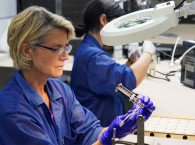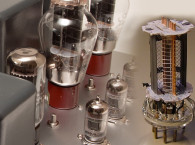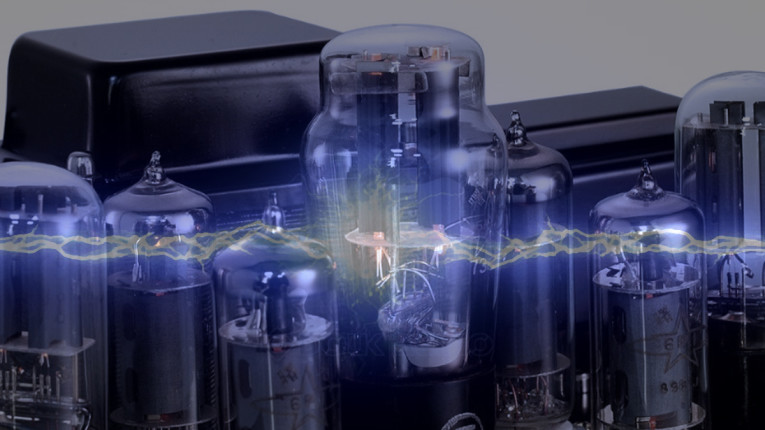
Before any tube (with the exception of cold cathode types such as 0Z4) can work properly, the heater must warm up the cathode enough to start emitting electrons which, in turn, produces a “space charge” around the cathode. This space charge actually supplies the electron current in a tube. The cathode emits electrons at a fairly even rate (this does vary a bit, instant to instant) into the space charge area surrounding the cathode.
The tube’s current is drawn from this space charge at a varying rate, which is determined by the signal applied to the control grid. This, of course, varies somewhat with time, having high peaks of current taken from the space charge, which is renewed at only a relatively constant rate. Too many peak currents will begin to deplete the space charge.
Cathode Stripping
When the current demanded by the signal exceeds the available electron charge, the electrons are then “pulled” directly from the cathode. This constitutes cathode stripping. When a tube is new, its cathode emissions are able to maintain the space charge sufficiently to keep up with most of the peak current demands, with only small amounts being pulled from the cathode itself resulting in little damage. As a tube ages and its cathode emission begins dropping off, the space charge can no longer keep up with current demands on peaks.
This gradually builds up more and more cathode stripping, especially when the tube is called on to continually supply frequent high current peaks. Owners who like to listen to music at very high sound levels will compensate by turning up the volume level, a self-defeating practice. This in turn causes even more cathode stripping. As this process continues, the space charge becomes more and more depleted.
This space charge has another function which rarely if ever is mentioned, even by so-called tube gurus. This space charge prevents arcing in a normal tube! When the space charge becomes sufficiently depleted, the tube can become susceptible to arcing. In many cases, the owner hasn’t a clue why the tube(s) arced. They may have actually seen the tube arc but cannot determine why this occurred. With no apparent malfunction of the amplifier circuitry and nothing to indicate the cause, guesswork fills in the blanks.

Change-Out
Many years ago, this causality was noted in power output tubes, but it was pointed out that this occurrence was quite rare. At that time, outside of theaters and PA systems, the average house did not place any heavy demands on output tubes a few watts were all that were needed. The heavy users always replaced their tubes on a regular basis, which prevented the tubes from suffering premature or old age maladies. Changing tubes regularly was cheaper than repairing amplifiers.
Today, with bigger and bigger power amplifiers, output tubes are being called upon to supply ever-increasing power levels, which they can! The problem is that these tubes will wear out faster, become unbalanced quicker, and, without due diligence on the part of the owner, will become susceptible to this type of failure mode far more often than ever thought of before.
Since most owners aren’t sure when tubes should be changed, they keep using them until something happens. Either the sound quality falls enough to be noticed or tubes start arcing and failing, the latter being the rarer event. Often, even when the owner pays attention to keeping the tubes balanced, they are used beyond the point at which they should be replaced, because of the power demand put on them. The tube is still “good,” even checking out okay on a tube tester, but its ability to provide a sufficient space charge for proper operation is declining.
You should replace these tubes before their space charge reaches a dangerous level. Tube arcing is not necessarily a result of a "bad" tube or a "bad" design. It is far more likely the result of using the tube longer than you should for the application you’re using it. An emissions-type tube tester is of some small help here, but unfortunately it cannot test for peak emission capability, so it is of somewhat limited use.
One way to tell that your tubes are in need of a change-out is by how much their bias points have changed since you first put them into the amplifier. Most tubes’ bias will have changed significantly as the tube ages. This can be of some help in determining when the tube is becoming weak. However, the problem is that each individual amplifier is going to be different, so that no set number can be easily assigned to “when” to change the tubes.
By the time it becomes difficult or impossible for your matched tubes to hold a “normal” match percentage, your tubes are likely already past the point at which they should have been changed. I’m not saying that every amplifier will suffer this problem or that it will occur often, but the fact is that it can occur often enough to cause significant damage to your amplifier. Much has to do with how and how often you use that amplifier. If it is ridden hard, it is much more likely to happen.
One thing is abundantly true: arcing is rarely ever seen in amplifiers that are not ridden hard; that is, called upon to supply very high power levels frequently. If you want to make those expensive output tubes last longer, turn down the volume a bit. Otherwise, be prepared to get out your wallet more frequently. It isn’t just the big power amplifiers that have this problem, any amplifier can arc.
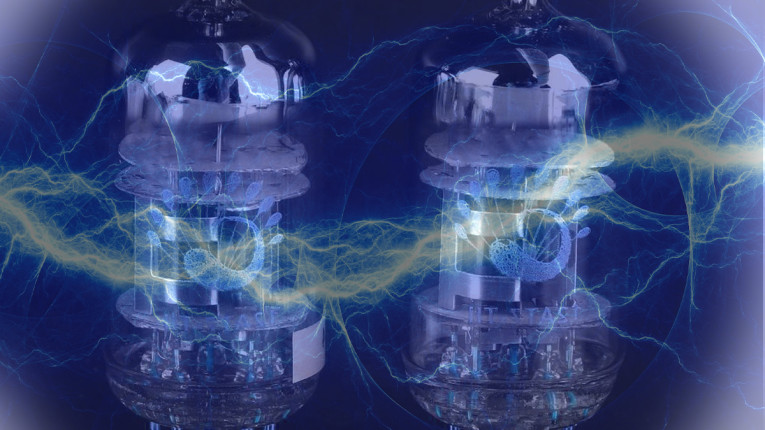
A Fairly Common Example
Consider someone who has a pair of very expensive, high powered amplifiers, is diligent to keep bias set on them, doesn’t run them too hard, but has experienced several seemingly unexplained arcing tubes, which blow plate fuse resistors (which is what they are for). In every instance, the factory said the tube was defective despite no evidence to support that conclusion. In some cases the tube that arced remained serviceable, others were damaged beyond use.
In either case, a tube that has suffered an arc should not be used again. The arc will have caused damage to the cathode whether or not a tube tester shows it. The condition that causes a tube to arc is not a defect, the tube is simply too worn out to work properly under demand. The owners who refused to believe that defective tubes were the sole cause were right. This problem has occurred both with NOS tubes no matter the brand and with recently made tubes. This failure mode doesn’t care whose tubes are in the amplifier; they can all suffer the arcing problem given the right conditions.
Forty years ago, manufacturers such as Mullard recommended replacing an output tube when its power output fell to 50% of normal. This was fine forty years ago, when amplifiers weren’t driven as they often are today. Power amps rarely were bigger than 40 or 50W, and two or four tubes could provide that much power easily.
The vast majority of amplifiers were under 20−25W, which a pair of tubes could output for a long time. A pair of KT88/6550s could put out 50−60W and have a good long life. Things have changed over the years. Many of today’s owners don’t have the knowledge they need to take care of their amplifiers, and neither do the manufacturers. It is not entirely the owner’s fault. Amplifier manufacturers rarely provide such information to their customers, and there is a wealth of poor or just plain wrong information on the web. Self-proclaimed tube gurus propagate much of this misinformation. Others who operate with a modicum of knowledge make assumptions based on little real knowledge and put that out on the web for others to read, and so it propagates all over, more myth becoming "fact."
It is doubtful that many tube amplifier manufacturers’ technical departments are that well versed in all of the nuances of tube operation either, because little if any documentation has been printed by them addressing this problem. Since this is something of a “new” problem that has shown up in recent years in amplifiers, little thought has been given to this mode of failure.

Solutions
Because the method of turning on filaments and preheating the tubes before applying plate voltage has been observed for many, many years in transmitters, the same practice has been observed in some power amplifiers. This alleviates cathode stripping in cold tubes, but does not protect tubes from arcing during operation. This is an entirely different situation calling for different procedures.
It is virtually up to the amplifier’s owner to guard against the possibility of arcing, and there are no pat answers on what numbers to use. You could make educated calculations, but they would be different for each particular amplifier. The easiest solution to this problem is to just turn the volume down and not push the tubes so hard. They will reward you with a longer lifespan and no arcing.
Cathode stripping has been addressed to some degree in publications, but cathode stripping at cold turn-on has largely been misaddressed. In the case of cathode stripping, arcing occurs only when sufficient damage has been caused by cold cathode stripping. Most amplifiers will not cause cathode stripping at turn-on. Delayed turn-on is a good idea in general but is not that important to tube life unless something has not been done right a bad circuit design, for example. In fact, receiving tubes are designed to withstand higher than maximum-rated voltage when cold.
Cathode damage results only when current is drawn sufficiently before the cathode has reached a minimum operating temperature. This condition does not normally exist in audio amplifiers, even larger power amps unless the designer has done a poor job designing it.
Contrary to popular belief, slow turn-on rectifiers such as the 5AR4/GZ34 is not a prerequisite to safe, long-life operation of your tubes. This “myth” was partially derived from the pre-heating requirements for high power transmitter tubes. This requirement does not extend to those transmitter tubes of “lower” power.
The tubes’ data sheet will specify whether preheating filaments is required. Popular tubes such as the 211 and 845 do not require pre-heating, however I would recommend pre-heating filaments of any tube with a plate voltage in excess of 750V as a matter of good practice. These power tubes are biased well below any danger zone for cathode stripping in audio applications. Even if the bias is derived from a tube rectifier, the bias voltage will be there soon enough to prevent any possibility of cathode stripping.
There is one exception to this situation, that is the use of solid-state rectifiers in the power supply. If solid-state rectifiers are used, it would be a very good idea to use pre-heating and delay plate voltage. Pre-heating your amplifier’s tubes isn’t a bad idea, it just isn’t necessary in most instances. It will not make your tubes last any longer! aX
This article was published in audioXpress, November 2004
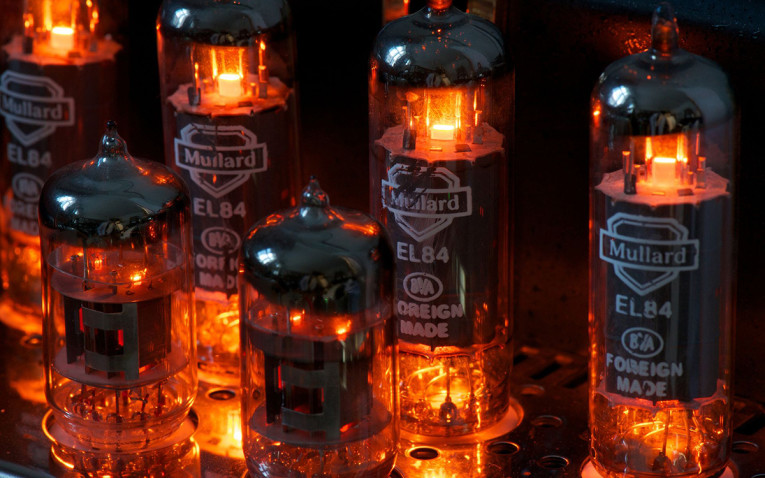
XPressMail Letters
In response to Edwin Pettis' article (“Why Power Tubes Arc,” Nov. ’04), I can state as a first-hand witness that oxide cathodes can indeed be damaged by applying anode B+ with the cathode cold because I managed to observe the effect when I worked at Svetlana. I put a Svetlana 300B on a test jig and repeatedly hit the anode with 450V with the filament cold. This caused the filament to “snap” due to the electrostatic attraction of the filament to the cathode (no, it was not caused by mechanical vibration; I was careful). Flakes of oxide were seen to fall off the filament. When I tested the tube afterward, its bias point had changed significantly I needed to change the negative grid bias from -103V to -122V to obtain the same 60mA plate current.
Mind you, this is a directly heated oxide filament. Indirectly heated tubes (of modern design, anyway) are less prone to the effect. I tried the same abuse on a 6550C and saw no noticeable effect. Older indirectly heated tube designs, however, might be susceptible to it.
This is more of a question of being conservative versus taking risks. If I were designing a large audio power amp, regardless of which tubes I used for output, I’d consider it prudent to time-delay the plate voltage. It isn’t done in lower-cost amps for simple cost reasons. Admittedly very few textbooks talk about cathode stripping. This is because in the old days tube rectifiers applied plate voltage slowly, so it was rarely seen.
Today’s big radio transmitters, with silicon plate rectifiers, usually apply plate voltage with a time delay, even if it isn’t likely to damage the tubes. This is considered good design. A big transmitter can run plate voltages of 12kV or more at several amps, and it’s a good idea to warm the tube filaments before hitting them with that much power especially if there is stray gas in a tube. It doesn’t make itself known until you put on the B+, whereupon the tube can arc, discharging and destroying itself and the power supply. Radio stations have been burned down by a transmitting tube that became slightly gassy. Better safe than sorry.
And I frequently see low-cost Chinese tube hi-fi amps that were damaged by a single gassy tube. Sometimes it just happens, even if the customer was very careful and bought well-tested NOS tubes. Gas in a tube is difficult, if not impossible, to detect sometimes. And the average tube hi-fi owner usually does not own a tube tester.
Reference Help
Power Vacuum Tubes Handbook by Jerry Whittaker (CRC Press, 1999) states on page 118 that oxide emitters are more easily damaged when subjected to bombardment from high-energy particles.
My copy of Electron Tubes in Industry by Henney and Fahnestock (3rd edition, McGraw-Hill, 1952) warns against applying anode voltage to a cold cathode (page 177). Unfortunately, this section deals with mercury-vapor thyratrons, not vacuum tubes. Both Electronic Designer’s Handbook by Landee, Davis, and Albrecht (McGraw-Hill, 1957) and Electronic Engineering Principles by John D. Ryder (Prentice-Hall, 1952) state that oxide cathode coatings are susceptible to oxygen poisoning and damage by gas ion bombardment. So they are usually seen only in tubes for use below 1000V.
Eric Barbour
Edward T. Dell responds:
Mr. Pettis’ views of the relative importance of possible cathode stripping do not agree with others of some repute, as evident from the correspondence from Regular Contributor Eric Barbour. Eric was a regular staff member in Svetlana's California research facility for a number of years and is a Senior Editor at Vacuum Tube Valley magazine.
I am on record since 1966, when my article “The Brute” was published in Stereophile. It advocates delayed B+ plate voltage as an attempt to prolong output tube life. I used multiple capacitor bypassed diodes to rectify the delayed B+ plate voltage by using a separate heater supply for the amplifier’s tubes.
Although I no longer have the reference that advocated this technique, I am quite certain that the early claims of Mullard for the use of the GZ34 tube rectifier were the source for my choice. The GZ34 was said to have a heating time of 11 seconds, which matched that of the EL34 and the KT types from Genalex. This meant that the cathodes were fully heated, or nearly so, before the B+ was applied to the plates, presumably avoiding any stress to the cathode coatings. The heating time of 5U4G rectifiers was supposedly only 5.5 seconds, if my memory is correct, although the tube manuals do not give data on the heating times, except for mercury vapor types.
Amperex, the US sales organization for the Dutch Philips tubes, ran a series of ads for the various types in Audiocraft magazine. The GZ34 was featured in several of these in 1958. The ad lists five characteristics of this rectifier, the fifth one being, “protection of costly power output tubes through delayed warm-up.”
Amperex was the US subsidiary of Philips, whose libraries exhibit the thorough and painstaking research which went into their tube designs. The GZ34 is obviously a smaller, more rugged rectifier with evident quality features.
I think one of the advantages of amateur construction practice is to build in as many operational features as possible since the design is not a candidate for mass production with limiting competitive cost factors. Stock-car enthusiasts will understand this motivation. In the case of output tube cathodes, even a small longevity advantage seems reasonable.
Ed T.Dell




